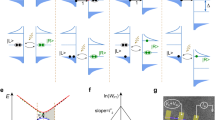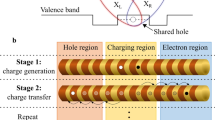Abstract
The ultimate limit in the operation of an electronic device is the manipulation of a single charge. Such a limit has been achieved in single-electron tunnelling devices1,2. However, these devices are based on multiple tunnel barriers and conductive islands, which are complex structures to fabricate. Here we demonstrate another type of device that can also manipulate elementary charge, but which is more suitable for large-scale integration. The device consists of two closely packed silicon wire-MOSFETs, which are commonly used building blocks of electronic circuits. We have developed a scheme to generate and store holes in the channels of either of these MOSFETs. Subsequently, holes can be transferred between the two MOSFETs at the level of an elementary charge, and their exact position can be monitored. This single-charge transfer device, which is operated at 25 K, is in effect a charge-coupled device3. This is also the first realization of a silicon-based device that manipulates elementary charge.
This is a preview of subscription content, access via your institution
Access options
Subscribe to this journal
Receive 51 print issues and online access
$199.00 per year
only $3.90 per issue
Buy this article
- Purchase on Springer Link
- Instant access to full article PDF
Prices may be subject to local taxes which are calculated during checkout




Similar content being viewed by others
References
Averin, D. V. & Likharev, K. K. in Mesoscopic Phenomena in Solids (eds Altshuler, B L., Lee, P. A. & Webb, R. B.) 173–271 (Elsevier, Amsterdam, 1991).
Grabert, H. & Devoret, M. H. (eds) Single Charge Tunnelling (Plenum, New York, 1992).
Barbe, D. F. (ed.) Charge-Coupled Devices (Springer, Berlin, 1980).
Likharev, K. K. Single-electron devices and their applications. Proc. IEEE 87, 606–632 (1999).
Averin, D. V. & Likharev, K. K. Coulomb blockade of tunneling, and coherent oscillations in small tunnel junctions. J. Low Temp. Phys. 62, 345–372 (1986).
Meriav, U. & Foxman, E. B. Single-electron phenomena in semiconductors. Semicond. Sci. Technol. 10, 255–284 (1995).
Takahashi, Y. et al. Silicon single-electron devices. Int. J. Electron. 86, 605–639 (1999).
Tans, S. J. et al. Individual single-wall carbon nanotubes as quantum wires. Nature 386, 474–476 (1997).
Likharev, K. K. Single-electron transistors: Electrostatic analogs of the DC SQUID's. IEEE Trans. Mag. 23, 1142–1145 (1987).
Fulton, T. A. & Dolan, G. J. Observation of single-electron charging effects in small tunnel junctions. Phys. Rev. Lett. 59, 109–112 (1987).
Kuzmin, L. S. & Likharev, K. K. Direct experimental observation of discrete correlated single-electron tunneling. JETP Lett. 45, 495–497 (1987).
Meriav, U., Kastner, M. A. & Wind, S. J. Single-electron charging and periodic conductance resonances in GaAs nanostructures. Phys. Rev. Lett. 65, 771–774 (1990).
Su, B., Goldman, V. J. & Cunningham, J. E. Observation of single-electron charging in double-barrier heterostructures. Science 255, 313–315 (1992).
Scott-Thomas, J. H., Field, S. B., Kastner, M. A., Smith, H. I. & Antoniadis, D. A. Conductance oscillations periodic in the density of a one-dimensional electron gas. Phys. Rev. Lett. 62, 583–586 (1989).
Ali, D. & Ahmed, H. Coulomb blockade in silicon tunnel junction device. Appl. Phys. Lett. 64, 2119–2120 (1994).
Takahashi, Y. et al. Fabrication technique for Si single-electron transistor operating at room temperature. Electron. Lett. 31, 136–137 (1995).
Dresselhaus, P. D., Ji, L., Han, S., Lukens, J. E. & Likharev, K. K. Measurement of single electron lifetimes in a multijunction trap. Phys. Rev. Lett. 72, 3226–3229 (1994).
Yano, K. et al. Room-temperature single-electron memory. IEEE Trans. Electron Devices 41, 1628–1637 (1994).
Fujiwara, A., Takahashi, Y., Murase, K. & Tabe, M. Time-resolved measurement of single-electron tunneling in a Si single-electron transistor with satellite Si islands. Appl. Phys. Lett. 67, 2957–2959 (1995).
Guo, L., Leobandung, E. & Chou, S. Y. A single-electron transistor memory operating at room temperatures. Science 275, 649–651 (1997).
Geerlings, L. J. et al. Frequency-locked turnstile device for single electrons. Phys. Rev. Lett. 64, 2691–2694 (1990).
Pothier, H. et al. Single electron pump fabricated with ultrasmall normal tunnel junctions. Physica B 169, 573–574 (1991).
Keller, M. W., Martinis, J. M., Zimmerman, N. M. & Steinbach, A. H. Accuracy of electron counting using a 7-junction electron pump. Appl. Phys. Lett. 69, 1804–1806 (1996).
Asahi, N., Akazawa, M. & Amemiya, Y. Single-electron logic device based on the binary decision diagram. IEEE Trans. Electron Devices 44, 1109–1116 (1997).
Fujiwara, A. et al. Double-island single-electron devices: A useful unit device for single-electron logic LSI's. IEEE Trans. Electron Devices 46, 954–959 (1999).
Single, C., Augke, R., Prins, F. E., Wharam, D. A. & Kern, D. P. Single-electron charging in doped silicon double dots. Semicond. Sci. Technol. 14, 1165–1168 (1999).
Cristoloveanu, S. & Li, S. S. Electrical Characterization of Silicon-On-Insulator Materials and Devices (Kluwer Academic, Boston, 1995).
Colinge, J. P. Silicon-On-Insulator Technology: Materials to VLSI (Kluwer Academic, Boston, 1997).
Fujiwara, A., Takahashi, Y. & Murase, K. Observation of single electron-hole recombination and photon-pumped current in Si single-electron transistors. Phys. Rev. Lett. 78, 1532–1535 (1997).
Lent, C. S., Tougaw, P. D., Porod, W. & Bernstein, G. Quantum cellular automata. Nanotechnology 4, 49–67 (1993).
Acknowledgements
We are grateful to K. Murase and T. Ogino for their encouragement. We also thank T. Yamaguchi, K. Yamazaki, H. Namatsu, Y. Watanabe, J. Hayashi, T. Saito and K. Kurihara for help in the device fabrication, and S. Horiguchi, H. Inokawa and Y. Ono for valuable discussions.
Author information
Authors and Affiliations
Corresponding author
Rights and permissions
About this article
Cite this article
Fujiwara, A., Takahashi, Y. Manipulation of elementary charge in a silicon charge-coupled device. Nature 410, 560–562 (2001). https://doi.org/10.1038/35069023
Received:
Accepted:
Issue Date:
DOI: https://doi.org/10.1038/35069023
This article is cited by
-
Surpassing the classical limit in magic square game with distant quantum dots coupled to optical cavities
Scientific Reports (2020)
-
Electron aspirator using electron–electron scattering in nanoscale silicon
Nature Communications (2018)
-
Three-waveform bidirectional pumping of single electrons with a silicon quantum dot
Scientific Reports (2016)
-
Dragging single electrons
Nature (2001)
Comments
By submitting a comment you agree to abide by our Terms and Community Guidelines. If you find something abusive or that does not comply with our terms or guidelines please flag it as inappropriate.



